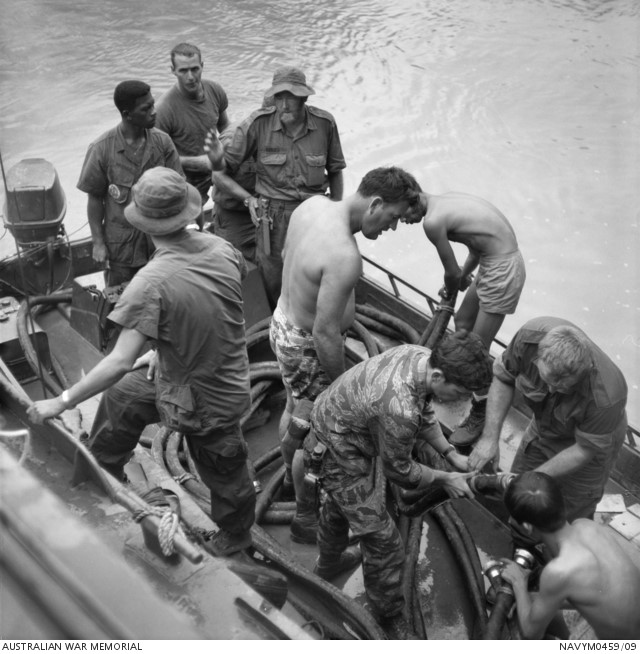Data extracted from John Perryman & Brett Mitchell, Australian Navy in Vietnam: Royal Australian Navy Operations 1965 – 1972, p.73-76. Reprinted with the kind permission of the Authors.
Photographs from the Australian War Memorial Collection licensed under CC BY-NC
Unit: Clearance Diving Team 3
Composition:
- LEUT A. Donald, RAN
- POCD B.J. Bailey
- POCD J.W. Thompson
- LSCD B.J. Bullock
- ABCD R.A. Barclay
- ABCD J.C. Pocklington
Deployment: August 1969 to March 1970
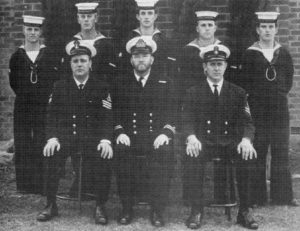
Rear: ABCD Bob Wojcik, ABCD ‘Tex’ Bullock, ABCD ‘Jock’ Kingston, ABCD John Pocklington,
ABCD ‘Banga’ Barclay. Front: POCD John Thompson, Lt. Alex Donald, POCD Bill Bailey.
Sydney, 1969.
The sixth contingent arrived in Vietnam on 13 August 1969. Their first assignment was a bunker busting operation in the Thanh Phu District on 26 August. Lieutenant Donald, accompanied by Petty Officer Bailey, Leading Seaman Bullock and Able Seaman Barclay, embarked in PCF 98 for passage to the Song Co Chien in the Mekong Delta, where a rendezvous was made with three more swift boats carrying a force of fifty Vietnamese troops and two American advisers. The flotilla then entered the nearby Rach Eo Loi River at 100 metre intervals. A protective force was landed at a designated position and conducted a clearing sweep on each side of the canal before Donald and his team was inserted. Proceeding cautiously, they approached the first enemy bunker with one man clearing an approach path while the others provided cover.
Upon reaching the entrance to a bunker the area visible was brassed up and a white phosphorus grenade introduced. A ten pound satchel charge was placed as far into the bunkers as possible by means of timber poles and a CS grenade was also introduced as the fuse was ignited.
Lieutenant Donald, report on bunker operation.
This procedure was successfully repeated along the banks of the Rach Eo Loi and the Rach Bang Cung. Working in energy-sapping heat topping 38 degrees Celsius, the team demolished and destroyed nine VC bunkers plus several structures and sampans. One VC was taken prisoner.
As the weather improved at the tail end of the monsoon season, the contingent made a positive start to their STABLEDOOR commitments throughout September, checking 140 ships. In the first of two operations for the month, Petty Officer Bailey and Leading Seaman Bullock were taken to the village of Phu Vinh in Vinh Binh Province on 22 September. Here they investigated a mine which had been recovered by local fishermen some three weeks earlier and left in the village square. The two divers discovered explosive weeping through the seams of the mine casing, making it highly volatile. Having evacuated the village, Bailey began dismantling the mine which was both alive and booby-trapped. The explosive charge was carefully removed and detonated in a safe area. The powerful charge made a crater measuring 10 feet deep and 25 feet wide. Bailey was subsequently mentioned in despatches.
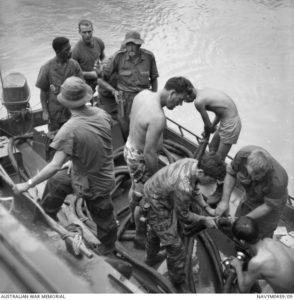
Members of the 6th Contingent, RAN Clearance Diving Team 3 (CDT3), work on the demolition of a barrier constructed by the Viet Cong to impede traffic on an inland waterway. The team’s tasks in Vietnam include ordnance demolition work, demolition of enemy bunkers, booby traps, mines, and enemy prepared underwater obstacles. CDT3 also regularly inspected the hulls and anchor chains of ships anchored in the bay off Vung Tau.
On 29 September, Lieutenant Donald, Petty Officer Thomson, and Able Seaman Barclay and Pocklington, accompanied by personnel from EODMUPAC Team 33, departed by Chinook helicopter to the Coastal Group 36 base near Long Phu. From here they and an ambush team proceeded up the Song Hau Giang (Bassac River) in two swift boats to a canal blocked by a VC log barricade, situated in the northern area of the Dung Island complex. The swift boats spent 20 minutes ‘greasing up’ the scrub on either side of the canal entrance before discovering that a sand bar impeded their entry. With late afternoon approaching, Donald decided to proceed in an armed Boston Whaler, accompanied by Thompson and an ambush team, to where the barricade was situated about 400 metres from the canal entrance. The swift boats later forced their way over the sand bar and approached to within 150 feet of the barricade. Here they provided suppression fire, strafing the canal banks with .50 calibre machine guns while the divers set to work on the barricade.
To destroy it, 24 hose charges were set aside for the operation, each packing 50lbs of high explosive. Aerial reconnaissance photographs had shown that more than 140 vertical logs had been used to construct the barricade. What the photographs did not show was a similar number of stakes laid in all direction beneath the surface. To deal with this the divers laced the hose charges through the barricade across the width of the canal and lit fuses at either end. The resultant explosion completely demolished the obstruction.
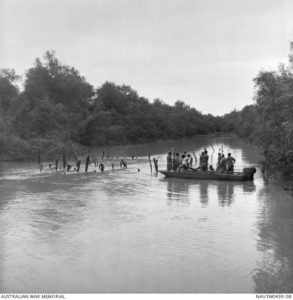
Members of the 6th Contingent, RAN Clearance Diving Team 3 (CDT3), work on the demolition of a barrier constructed by the Viet Cong to impede traffic on an inland waterway.
Donald’s earlier decision to proceed in the Boston Whaler, forfeiting the protection afforded by the swift boats, was one he had not taken lightly. The Dung Island complex was a known VC hotspot and previous patrols in the area had invariably been ambushed. Two days later a Cobra gunship and two Huey slicks were shot down barely 200 metres from where the team had destroyed the barricade.
During October 1969 CDT3 concentrated primarily on their STABLEDOOR commitment. Favourable weather allowed diving operations to go ahead on all but three occasions and 240 ships were searched without incident. An opportunity also presented itself for Leading Seaman Bullock to participate in a personnel exchange with Lieutenant (Junior Grade) S. Wells USN, and work with EDOMUPAC Team 39 in USS Benewah (APB 35), flagship of Task Force 117.
CDT3 participated in just one operation in October, but again it exposed them to the dangers of operating in the remote confined waterways and canals unique to the Mekong Delta. A reconnaissance mission, aimed to gather information on offensive bunkers along a narrow canal near the village of Ap Thu Truoc at the mouth of the Song Co Chien had been authorised. The narrowness of the five-metre wide canal made it necessary to proceed in two fibreglass skimmers. These craft were powered by twin 40-horsepower outboard motors and armed only with a forward-mounted M60 machine gun. Supporting forces included two Coast guard cutters used to seal off each end of the canal, and two OV-10 Bronco aircraft for the provision of close air support. The skimmers proceeded at maximum speed up the canal, where they observed and recorded the locations of several bunkers and searched a number of sampans. Lieutenant Donald later recalled that ‘the skimmers were taken under fire once during the foray. The retaliatory fire “terminated” Victor Charlies’ (VC) interest in any other proceedings’. A tense situation developed when canal weed fouled propellers, creating an anxious delay for all concerned.
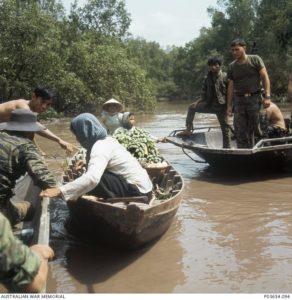
RAN, USN and Army of the Republic of Vietnam (ARVN) soldiers examining a wooden sampan for contraband. The Australians, members of Clearance Diving Team 3 (CDT 3), worked in conjunction with the Americans and ARVN and were responsible for detecting and clearing enemy obstructions and mines in the delta area. They frequently undertook patrol duties in USN river patrol craft and smaller outboard motor powered boats when required to stop and examine craft such as this one. At left, with back to camera,is Lieutenant Alex Donald RAN DSC, Commanding Officer of the Australian unit, who is wearing US pattern camouflage uniform, bush hat and 1911A1 Colt .45 calibre pistol. In front of him an ARVN soldier is pointing to the three womens’ boatload of bananas and pineapples.
In November, all team members participated in further operations against enemy bunker complexes on Dung Island, in Ke Sach (Ba Xuyen Province) and at Ap An Niah (Phong Dinh Province), and were supported variously by swift boats, Huey helicopters and South Vietnamese troops. Collectively, 49 bunkers, 20 structures and tunnels were destroyed. On 16 November, Lieutenant Donald, assisted by Petty Officer Thompson, Leading Seaman Bullock and Able Seaman Pocklington, destroyed a Mohawk aircraft which had earlier crashed about half a mile to seaward off the coast of Vinh Binh Province.
A month later Donald, Petty Officer Bailey and Able Seaman Barclay were flown into the Rung Sat Special Zone, to remove live ordnance from the wreckage of an OV-10 Bronco which had crashed during a low-level reconnaissance mission. With the helicopter unable to land on the swampy mangroves, Donald and his team had to jump out several feet above ground and slog their way through 200 metres of thigh deep mud to where the aircraft wreckage lay. As they went about their task, a 30-strong security force of South Vietnamese Marines was provided for their protection. It transpired that the wreckage and ordnance was completely burnt out, and there was no discernible sign of the occupants as the cockpit was buried several metres beneath the mud. The divers and their equipment were later extracted without incident by a Chinook helicopter and airlifted back to Vung Tau.
During the first two months of 1970, CDT3 personnel took part in two separate search and destroy operations against VC bunker and tunnel complexes along a stretch of the lower Saigon River, some 40 kilometres north of Saigon. In the first mission, Petty Officer Thompson and Able Seaman Barclay were among a team of seven allied specialist EOD personnel, under Commissioned Warrant Officer G. E. Wentre, USN, who, between 10 and 17 January 1970, destroyed thirty-seven bunkers, eight tunnels and one tunnel complex, together with several spider holes, wells and an observation post. Supported by two river patrol boats (PBR) and a squad of ten Vietnamese Regional Force troops, they also captured four sampans, weapons, ammunition and documents. Wentre later observed that Thompson and Barclay ‘displayed the utmost in professionalism and competence’ and ‘their constant participation in all phases of the operations reflected a standard of excellence second to none’. Petty Officer Bailey and Leading Seaman Bullock operated in the same area from late January to 11 February. This time a six-man EOD team was supported by three PBRs and 20 Regional Force troops. On 10 February the force engaged the enemy, killing at least four VC.
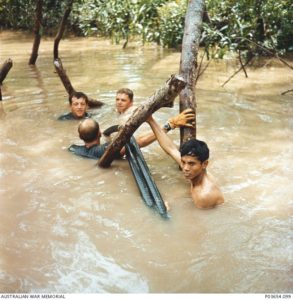
USN, RAN and Army of the Republic of Vietnam (ARVN) personnel attaching Mark 8 hose charges to wooden stakes driven into the river bed of a tributary by the Viet Cong to interrupt local traffic. The Australians, members of Clearance Diving Team 3 (CDT 3), occasionally worked in conjunction with the Americans and ARVN, and were responsible for detecting and clearing enemy obstructions and mines in the delta area.
VC forces inhabiting Dung Island, undeterred by CDT3’s removal of a previous log barricade in the late September 1969, had, over time, industriously built another three barricades in the same canal. Donald, Bailey and Bullock joined a 12-man EOD team tasked with a job of removing these new obstructions on 15 February. The team, which included seven American and two Vietnamese naval personnel, was supported by a security force comprising of a Coast Guard cutter, two swift boats, 100 Regional Force troops and two light observation helicopters. The first two barricades, which were small and positioned within ten metres of each other, were destroyed by one dozen hose charges. Three kilometres away, a much larger barricade spanning the 70-metre wide canal had been constructed from 300 logs placed vertically in five metres of water. The operation was brought to a successful climax when 52 hose charges initiated a spectacular explosion. The next day, 20 enemy bunkers and a similar number of other structures were destroyed along the banks of a nearby canal, and three Vietnamese were taken into custody.
Donald’s contingent began their final month of active service with a salvage operation on a downed A-1 Skyraider aircraft in the Song Ham Luong which involved the recovery of the pilot’s body, the ejection seat and wing cannons. The seventh contingent arrived in Saigon on 11 March. By 20 March, of the sixth contingent, all but Donald had departed. He completed the handover to his successor, Lieutenant Ross Blue, RAN, on 31 March, concluding a highly productive deployment.
In just over six months, Donald and his men searched 1,387 ships’ cables in support of Operation STABLEDOOR and completed 39 diving tasks. They had responded to 107 calls for EOD assistance, worked on six crashed aircraft, participated in 17 search and destroy operations against VC targets and destroyed four barricades in the Mekong Delta. In addition to Petty Officer Bailey’s mention in despatches, Lieutenant Donald was awarded the Distinguished Service Cross for ‘cool, decisive leadership’.
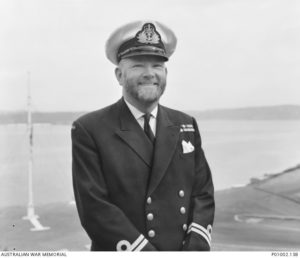
Lieutenant A. Donald, DSC, RAN. Lieutenant Donald was awarded the Distinguished Service Cross for his services in Vietnam with Clearance Diving Team No. 3, 6th Contingent, from August 1969 to April 1970.

